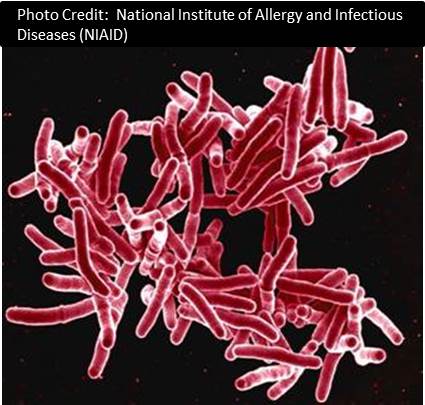
Tuberculosis
WHAT IS TUBERCULOSIS?
Tuberculosis (TB) is an infection caused by Mycobacterium tuberculosis and some other Mycobacterium species. This bacterium mostly infects the lung, leading to classical TB. Other internal organs, the central nervous system and the musculoskeletal system can also be infected. Infections can be fatal, if untreated. Due to frequent development of antibiotic resistance a multi-drug therapy is often needed in treatment. Tuberculosis was a frequent cause of death in the late 19th century. While numbers dropped in the 20th century, the disease has re-emerged over the last 20 years. In 2013, 9 million people fell ill with TB and 1.5 million people died. TB is second only to HIV/AIDS as the greatest killer worldwide due to a single infectious agent.
WHAT ARE THE SYMPTOMS?
Symptoms of lung TB include a bad cough that lasts 3 weeks or longer, pain in the chest, coughing up blood or sputum, weakness or fatigue, weight loss, no appetite, chills, fever and sweating at night. Millions of people have latent TB infections. People with latent TB infections have inactive Mycobacterium in their bodies, but they do not show symptoms, nor do they infect others. However, people with latent TB may develop full blown TB in the future.
HOW IS IT TRANSMITTED?
It is mainly transmitted from person to person via droplet transmission (aerosols) from the lungs of people with active pulmonary disease. Secondary transmission routes include residues of infectious sputum on medical instruments and surfaces in the direct patient environment. Other body fluids, secretions and excretions may contain the pathogen. The infectious bacterium may survive in dust or on dry surfaces for several days. Working in healthcare has been identified as a risk factor for acquisition of TB.
HOW IS IT CONTROLLED?
There is currently no completely effective vaccine available against tuberculosis. Control is focused on detecting infectious cases, contact investigation to identify other people at risk and treating them. Appropriate hygienic practices must be observed to avoid spread of TB. These include isolation of actively infected individuals, protective masks for staff in contact with the infected and the use of other personal protective equipment including clothing and gloves. Cleaning and disinfection is vital, but due to the unique structure of their cell wall Mycobacteria are less susceptible to disinfectants than other bacteria. Disinfectants effective against Mycobacterium must explicitly be labeled as tuberculocidal. Hand hygiene is also important.
REFERENCES AND FURTHER INFORMATION
1) http://www.cdc.gov/tb/topic/basics/default.htm
2) http://ecdc.europa.eu/en/healthtopics/tuberculosis/pages/index.aspx
3) ECDC, The first European Communicable Disease Epidemiological Report, June 2007 http://ecdc.europa.eu/en/publications/_layouts/forms/Publication_DispForm.aspx?List=4f55ad51-4aed-4d32-b960-af70113dbb90&ID=16
4) BMC Infectious Diseases 2010, 10:107 doi:10.1186/1471-2334-10-107
5) http://www.rki.de/DE/Content/Infekt/Krankenhaushygiene/Erreger_ausgewaehlt/Tuberkulose/Uebersicht.html
6) http://www.ncbi.nlm.nih.gov/books/NBK144013/
7) http://www.who.int/mediacentre/factsheets/fs104/en/#


